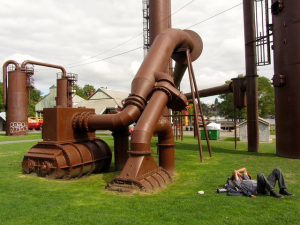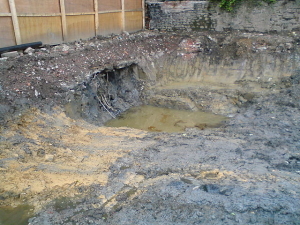
Gas Works Park, a Seattle brownfield redeveloped into a popular park, courtesy of Richie Diesterheft, CC BY-SA 2.0.
You’ve probably heard of brownfields—abandoned or underutilized properties with real or perceived contamination. But you may not understand the risks they pose if not properly assessed and remediated, or the opportunities they present if carefully redeveloped. Today we examine the benefits of brownfield remediation and redevelopment, areas where we’ve been doing research for several decades.
In 1995, the U.S. Environmental Protection Agency (EPA) launched the Brownfields Program to empower states, Tribes, communities, and other stakeholders to assess, clean up, sustainably reuse, and prevent future brownfield sites. Throughout the mid-1990s, many states implemented Voluntary Cleanup Programs to encourage brownfield cleanup and redevelopment. The brownfield remediation effort was expanded in 2002 when President Bush signed the Small Business Liability Relief and Brownfields Revitalization Act (the Brownfields Law).
According to the Brownfields Law, a brownfield is “real property, the expansion, redevelopment, or reuse of which may be complicated by the presence or potential presence of a hazardous substance, pollutant, or contaminant.” Brownfields generally pose lower risks to human health than other types of hazardous waste sites because they exclude sites listed or proposed for listing on the National Priorities List (Superfund sites) and sites remediated under the Toxic Substances Control Act of 1976. Many brownfields are former service stations, dry cleaning facilities, factories, warehouses, shipyards, or military bases. They could be residential properties with underground storage tanks or that have served as meth labs. Given the increasingly common practice of hydraulic fracturing in recent years, they might also be sites where fracking activities have occurred. Many estimates put the number of brownfields in the United States at more than 450,000 sites.

Soil contamination encountered during brownfield remediation, courtesy of Wikimedia Commons user Dumelow, CC BY-SA 4.0.
What are the benefits of redeveloping brownfield properties? Many brownfields are unsightly and can have all kinds of dangers—dilapidated buildings, debris, illegally dumped garbage, and even toxic chemicals. Left untreated, they may reduce nearby property values, increase potential for exposures to harmful chemicals, decrease availability of safe spaces for recreation, and contribute to increased substance abuse and crime rates. Cleaning up and reusing these properties can protect the environment from contamination, improve air and water quality, improve public health and safety, reduce neighborhood blight, increase local tax bases, facilitate job growth, and relieve development pressure on greenspaces.
Public investments in brownfield cleanup leverage private investment, typically in a range from $7 to $19 in private funds per public dollar invested. Through fiscal year 2014, on average, $17.54 was leveraged for each dollar EPA expended on brownfields, and 8.2 jobs were leveraged per $100,000 of EPA brownfield funds expended on assessment, cleanup, and Revolving Loan Fund cooperative agreements. EPA brownfield funds had leveraged 116,963 jobs nationwide by September 1, 2015.
An econometric study found that residential property values increased by 5.1% to 12.8% near brownfield sites once cleanup was completed. In a follow-up study of a nationally representative sample of brownfield properties published by the National Bureau of Economic Research (NBER), the researchers found that the average housing price increase due to brownfield remediation was 5% to 15.2%. The researchers concluded that the EPA Brownfields Program yields a positive, statistically significant, but highly localized effect on housing prices and that the total economic benefits of brownfield remediation exceed the costs by an order of magnitude.
Because many brownfields are located in densely developed urban areas, these sites tend to have greater location efficiency than alternative development sites, meaning they are located to maximize accessibility and overall affordability. This results in energy savings and reduced emissions. Results of five EPA pilot studies showed a 32% to 57% reduction in vehicle miles traveled (VMT) when development occurred at a brownfield site rather than a greenfield site. Fewer VMT leads to a reduction in air pollution emissions, including greenhouse gases. These same EPA site comparisons showed that brownfield redevelopment improved water quality by reducing stormwater runoff 47% to 62% compared to greenfield site development. Another study found similar reductions in VMT of 20% to 40% for development of brownfield versus greenfield sites, with accompanying reductions in air pollution and greenhouse gas emissions.
Cleaning up brownfield and putting them to productive new uses clearly offers substantial benefits to governments, communities, and property owners. If you’d like to learn more about the risks and opportunities of brownfield redevelopment, or discuss how various tax credits can be used to redevelop a brownfield site, browse our website to read more about our past work with brownfields, or contact us directly to discuss how we can help.





Recent Comments